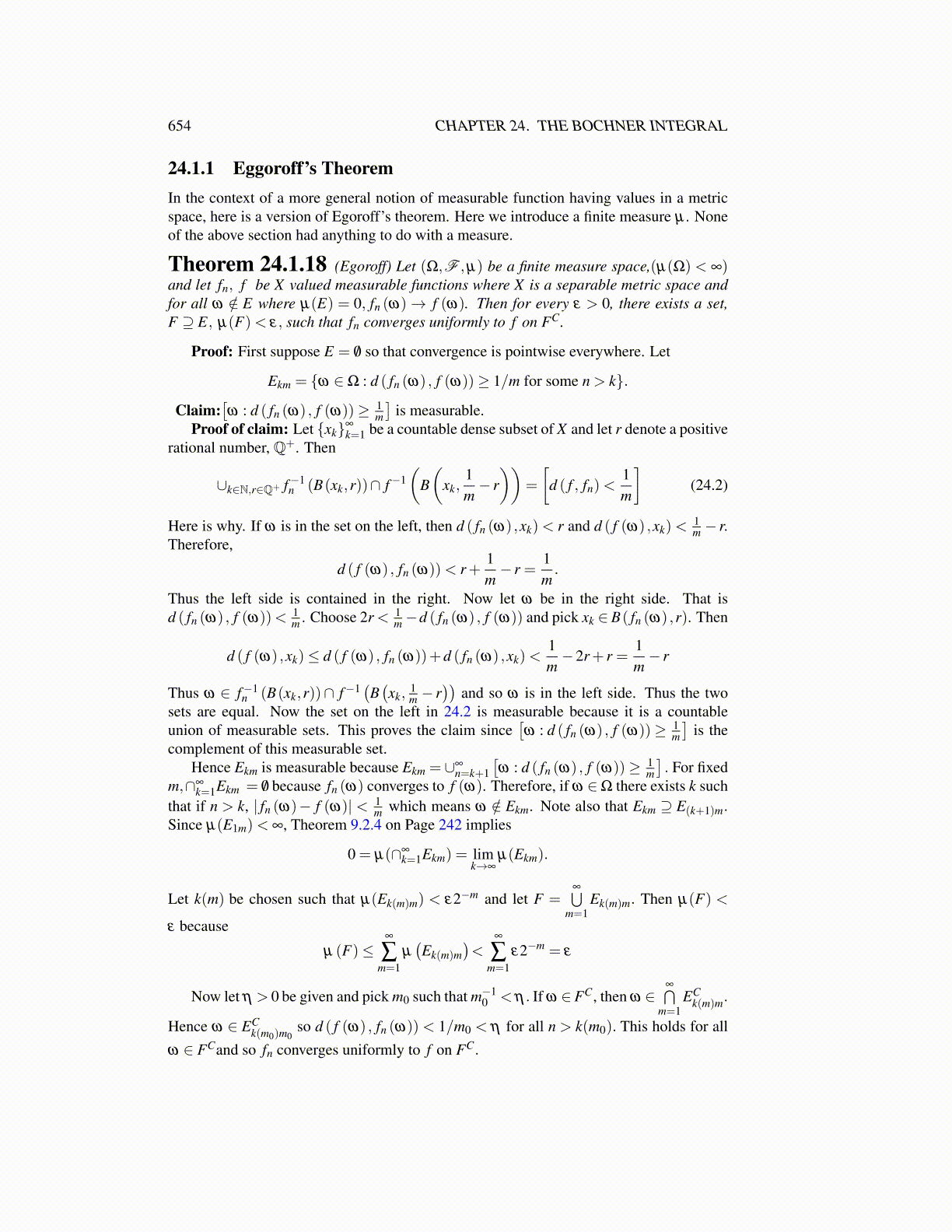
654 CHAPTER 24. THE BOCHNER INTEGRAL
24.1.1 Eggoroff’s TheoremIn the context of a more general notion of measurable function having values in a metricspace, here is a version of Egoroff’s theorem. Here we introduce a finite measure µ . Noneof the above section had anything to do with a measure.
Theorem 24.1.18 (Egoroff) Let (Ω,F ,µ) be a finite measure space,(µ(Ω) < ∞)and let fn, f be X valued measurable functions where X is a separable metric space andfor all ω /∈ E where µ(E) = 0, fn (ω)→ f (ω). Then for every ε > 0, there exists a set,F ⊇ E, µ(F)< ε, such that fn converges uniformly to f on FC.
Proof: First suppose E = /0 so that convergence is pointwise everywhere. Let
Ekm = {ω ∈Ω : d ( fn (ω) , f (ω))≥ 1/m for some n > k}.
Claim:[ω : d ( fn (ω) , f (ω))≥ 1
m
]is measurable.
Proof of claim: Let {xk}∞
k=1 be a countable dense subset of X and let r denote a positiverational number, Q+. Then
∪k∈N,r∈Q+ f−1n (B(xk,r))∩ f−1
(B(
xk,1m− r))
=
[d ( f , fn)<
1m
](24.2)
Here is why. If ω is in the set on the left, then d ( fn (ω) ,xk)< r and d ( f (ω) ,xk)<1m − r.
Therefore,
d ( f (ω) , fn (ω))< r+1m− r =
1m.
Thus the left side is contained in the right. Now let ω be in the right side. That isd ( fn (ω) , f (ω))< 1
m . Choose 2r < 1m−d ( fn (ω) , f (ω)) and pick xk ∈ B( fn (ω) ,r). Then
d ( f (ω) ,xk)≤ d ( f (ω) , fn (ω))+d ( fn (ω) ,xk)<1m−2r+ r =
1m− r
Thus ω ∈ f−1n (B(xk,r))∩ f−1
(B(xk,
1m − r
))and so ω is in the left side. Thus the two
sets are equal. Now the set on the left in 24.2 is measurable because it is a countableunion of measurable sets. This proves the claim since
[ω : d ( fn (ω) , f (ω))≥ 1
m
]is the
complement of this measurable set.Hence Ekm is measurable because Ekm = ∪∞
n=k+1
[ω : d ( fn (ω) , f (ω))≥ 1
m
]. For fixed
m,∩∞k=1Ekm = /0 because fn (ω) converges to f (ω). Therefore, if ω ∈Ω there exists k such
that if n > k, | fn (ω)− f (ω)| < 1m which means ω /∈ Ekm. Note also that Ekm ⊇ E(k+1)m.
Since µ(E1m)< ∞, Theorem 9.2.4 on Page 242 implies
0 = µ(∩∞k=1Ekm) = lim
k→∞µ(Ekm).
Let k(m) be chosen such that µ(Ek(m)m) < ε2−m and let F =∞⋃
m=1Ek(m)m. Then µ(F) <
ε because
µ (F)≤∞
∑m=1
µ(Ek(m)m
)<
∞
∑m=1
ε2−m = ε
Now let η > 0 be given and pick m0 such that m−10 < η . If ω ∈FC, then ω ∈
∞⋂m=1
ECk(m)m.
Hence ω ∈ ECk(m0)m0
so d ( f (ω) , fn (ω)) < 1/m0 < η for all n > k(m0). This holds for all
ω ∈ FCand so fn converges uniformly to f on FC.